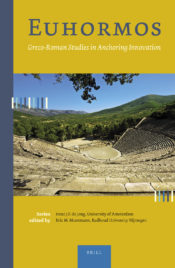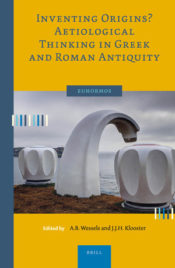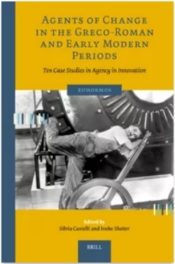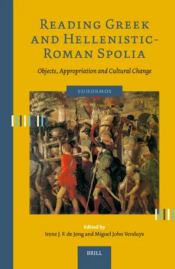The Anchoring Innovation programme has initiated its own open access book series with Brill, called Euhormos.
Euhormos (εὔορμος) is an international book series intended for monographs and collective volumes on classical antiquity. Specifically, it welcomes manuscripts related to the concept of ‘anchoring innovation’ by classical scholars of all disciplines from all over the world. All books will be published Open Access.
Submission of manuscripts/further questions
If you are interested to publish a book in this series, please contact Brill’s Assistant Editor for Classical Studies, Giulia Moriconi, at moriconi@brill.com.

EUHORMOS is an international book series intended for monographs and collective volumes on classical antiquity. Specifically, it welcomes manuscripts related to the concept of ‘anchoring innovation’ by classical scholars of all disciplines from all over the world. All books will be published in Open Access (online) as well as in print.
The series publishes book-length studies (single-authored or edited) of ancient innovations and their societal perceptions and valuations, in particular in connection with their ‘anchoring’, the various ways in which ‘the new’ could (or could not) be connected to what was already familiar. ‘The new’ is not restricted to the technical or scientific domains, but can include the ‘new information’ imparted by speakers through linguistic means, literary innovation, political, social, cultural or economic innovation, and new developments in material culture.
EUHORMOS is one of the results of the Dutch so-called Gravitation Grant (2017), awarded to a consortium of scholars from OIKOS, the National Research School in Classical Studies. Seehttps://www.ru.nl/oikos/anchoring-innovation.
EUHORMOS is the Homeric term for a harbour ‘in which the anchoring is good’. Under this auspicious title, we aim to publish a book series striving to afford ‘good anchorage’ to studies contributing to a better understanding of ‘anchoring innovation’ in Greco-Roman Antiquity.
For sending your proposal or submitting manuscripts for the series, please contact Brill’s Assistant Editor for Classical Studies, Giulia Moriconi.

The apostle Peter gradually became one of the most famous figures of the ancient world. His almost undisputed reputation made the disciple an exquisite anchor by which new practices within and outside the Church could be established, including innovations in fields as diverse as architecture, art, cult, epigraphy, liturgy, poetry and politics. This interdisciplinary volume inquires the way in which the figure of Peter functioned as an anchor for various people from different periods and geographical areas. The concept of Anchoring Innovation is used to investigate the history of the reception of the apostle Peter from the first century up to Charlemagne, revealing as much about Peter as about the context in which this reception took place.
The entire volume is published in open access: https://doi.org/10.1163/9789004425682

Aetiologies seem to gratify the human desire to understand the origin of a phenomenon. However, as this book demonstrates, aetiologies do not exclusively explore origins. Rather, in inventing origin stories they authorise the present and try to shape the future. This book explores aetiology as a tool for thinking, and draws attention to the paradoxical structure of origin stories. Aetiologies reduce complex ambivalence and plurality to plainly causal and temporal relations, but at the same time, by casting an anchor into the past, they open doors to progress and innovation.
The entire volume is published in open access: https://doi.org/10.1163/9789004500433

Canonisation is fundamental to the sustainability of cultures. This volume is meant as a (theoretical) exploration of the process, taking Eurasian societies from roughly the first millennium BCE (Babylonian, Assyrian, Persian, Greek, Egyptian, Jewish and Roman) as case studies. It focuses on canonisation as a form of cultural formation, asking why and how canonisation works in this particular way and explaining the importance of the first millennium BCE for these questions and vice versa. As a result of this focus, notions like anchoring, cultural memory, embedding and innovation play an important role throughout the book.

Who or what makes innovation spread? Ten case-studies from Greco-Roman Antiquity and the early modern period address human and non-human agency in innovation. Was Erasmus the ‘superspreader’ of the use of New Ancient Greek? How did a special type of clamp contribute to architectural innovation in Delphi? What agents helped diffuse a new festival culture in the eastern parts of the Roman empire? How did a context of status competition between scholars and poets at the Ptolemaic court help deify a lock of hair? Examples from different societal domains illuminate different types of agency in historical innovation.
The entire volume is published in open access:
https://doi.org/10.1163/9789004680012.

Plundering and taking home precious objects from a defeated enemy was a widespread activity in the Greek and Hellenistic-Roman world. In this volume literary critics, historians and archaeologists join forces in investigating this phenomenon in terms of appropriation and cultural change. In-depth interpretations of famous ancient spoliations, like that of the Greeks after Plataea or the Romans after the capture of Jerusalem, reveal a fascinating paradox: while the material record shows an eager incorporation of new objects, the texts display abhorrence of the negative effects they were thought to bring along. As this volume demonstrates, both reactions testify to the crucial innovative impact objects from abroad may have.
The entire volume is published in open access: https://doi.org/10.1163/9789004682702.

Scholarship surrounding the standard varieties of Ancient Greek (Attic, the Koine, and Atticistic Greek) focused from its beginnings until relatively recently on determining fixed uniformities or differences between them. This collection of essays advocates for understanding them as interconnected and continuously evolving and suggests viewing them as living organisms shaped by their speakers and texts. The authors propose approaches that integrate linguistics, sociolinguistics, and literary studies to explore how speakers navigate linguistic norms and social dynamics, leading to innovations and reshaping of standards. Each contribution challenges the dichotomy between standards and deviations, suggesting that studying linguistic diversity through socio-literary interconnectedness can enrich our understanding of language history and cultural wealth.
The entire volume is published in open access: https://doi.org/10.1163/9789004500433

This collection of essays explores processes of innovation in Greco-Roman technology and science. It uses the concept of ‘anchoring’ to investigate the microhistories of technological and scientific practices and ideas. The volume combines broad, theoretical essays with more targeted case studies of individual inventions and innovations. In doing so, it moves beyond the emphasis on achievement that has traditionally characterized modern scholarship on ancient technology and science. Instead, the chapters of this volume analyse the manifold ways in which new technologies and ideas were anchored in what was already known and familiar, and highlight how, once familiar, technologies and ideas could themselves become anchoring points for inventions and innovations.
The entire volume is published in open access: https://doi.org/10.1163/9789004500433

Social Psychology and the Ancient World: Methods and Applications fosters an interdisciplinary dialogue between classics and social psychology. Classicists use modern social-psychological insights to interpret ancient texts, while social psychologists engage with classical case studies to refine their own conceptual frameworks. This dialogue unfolds through an innovative structure: thematic sections introduced by social psychologists are paired with wide-ranging case studies by classicists, covering topics such as the psychology of tragic characters, comedic group dynamics, and the cognitive processes at play in oracles and deification. The volume offers methodological guidance for reconstructing the social psychology of past societies, addressing questions like: How did ancient Greeks understand character? How did laughter shape social cohesion? What role did emotional contagion play in narratives? How did ancient societies accommodate religious innovation? And above all: how do we know, and how can we properly investigate such questions?
The entire volume is published in open access: https://doi.org/10.1163/9789004500433